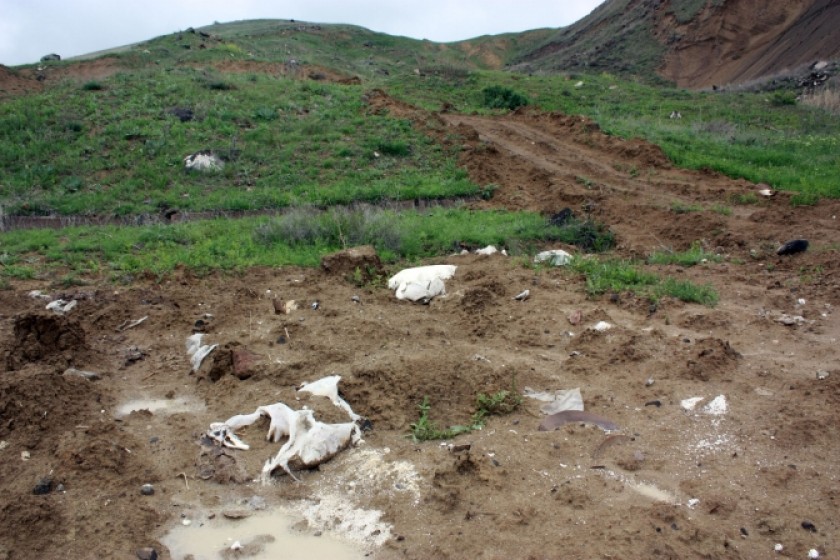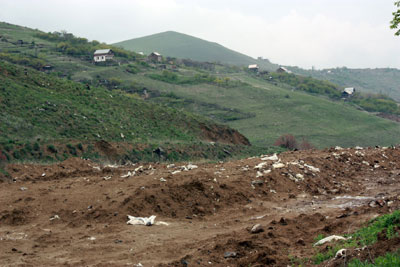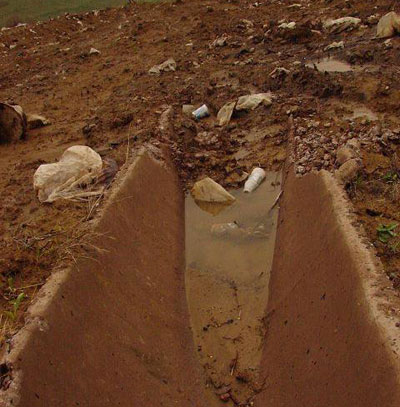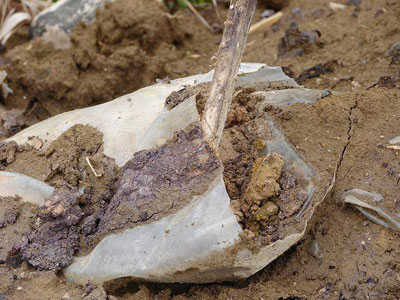
An Environmental Disaster in the Making Just Outside Yerevan
The Erebuni Toxic Waste Dump Has Been Neglected for Years
“We must immediately issue a warning – to stop the rains from mixing with the toxic wastes. They are flowing down.”
This was the alarm made by a top government official who wishes to remain anonymous. He says he’ll lose his job otherwise. I understand his plight. The next day we leave for the toxic dump “discovered” in the Erebuni reserve. You can’t travel to the site by a regular vehicle, so we tried renting a Vilis jeep. We don’t negotiate with Ishkhan for long in the village of Mushakan. He wanted 20,000 AMD for use of the Vilis. After a few words, he came down in price to 15,000. A Yezdi, Ishkhan told us, that while we make $50 for a few photos and that he wanted a piece of it. The rain was wafting down gently and we had no desire to try and convince him otherwise.
Aching joints and dead chickens
The residents of Mushakan had heard about the toxic dump; but only had heard. Ishkhan lives with his two brothers in the one house. While he went to Vardashen to fill the vehicle with gas, we talked to the three women of the house. We talked about the dangers posed by the dump. One of the wives said that all her chickens had mysteriously dropped dead and that the dump might be the cause. I replied it was unlikely. She added that her neighbors’ chickens had met a similar fate. Twenty-three year-old Armen, hearing our conversation, said that he had joint pain and that he was getting short of breath.
“Can it be from the dump?’ he asked. I answered that it was possible. He said that he spends all day walking around the site. To that, an elderly but spry woman said, “Dear boy, I have tended to animals for fifteen years below that dump. Do I look sick to you?” Many local residents take their animals near the site.

The jeep approaches the top of the mountain. Here, the mud resembles the mud in Artsakh at a place called “Mud Valley”. Your feet get stuck in the mire and movement s next to impossible. The entire area is muddy. There are plastic bags everywhere you look. Some are ripped and the toxic wastes are oozing out. The toxic wastes, have taken on various shades. Mixing with the rain, small rivulets of poison are flowing around the site. Photographer Hakob Poghosyan and environmentalist Mariam Sukhudyan are taking photographs and shooting video of the site.

Villagers graze livestock at the toxic site
The concrete gutters built around the dump to keep the rain water from entering have either cracked or filled with soil in places. The toxic wastes, mixed with the rain water, are now flowing out towards the fields and grazing lands used by the villagers. The meat and milk from the grazing cows is being sold to the public in stores. Back in Yerevan, government officials are trying to depict the calamity as a run-of-the-mill incident. They say they are devising projects and drafting studies. The fact is that for two months straight, the Nature Protection and Emergency Situations Ministries, never warned the public, even they knew what was going on. Till today, rain water freely flows over the dump, taking the wastes with them. There are about 577 tons of toxic wastes buried at the site today. In one of the documents in my possession, it notes what amounts of waste from Armenia and regionally have been transported here.

In 1972 the Soviet government outlawed the use of certain agricultural insecticides, and 500 metric tons of the prohibited substances were collected from villages and warehouses throughout Armenia. Among these were persistent organic pollutants that don't decompose for 30-40 years, and when they do, give rise to metabolites with the same toxic characteristics. In the 1970s, burial was considered the safest and most effective method of destroying insecticides.
According to Lilik Simonyan, a representative of the “Armenian Women for Health and a Healthy Environment”, NGO, 60% of the wastes are persistent organic chlorine solutions. In the human organism, any kind of persistent organic pollutants contribute to the development of malignant tumors. This is an emergency not only for those living in the neighborhood, since pollutants affect people through the air as well.
Toxic dump was unregulated for years
In the 1970’s, the most effective and safe way to deal with the toxic wastes was to bury them. That’s why the site is also called the “cemetery”. In 1982, the Soviet Armenian government decided to construct a cement “coffin” above the village of Bardzrashen in the Artashat region (today this site is located in the Erebuni community of Yerevan). The dump was lined with clay to prevent the wastes from leaching into the soil. The site, at the time, had a security office and was fenced off.

During those years, periodic inspections took place at the site. After independence till 2004, no monitoring at all was carried out. The guards were gone and the fence had collapsed. Later on, the outlying fields were allocated for farming purposes. Houses were built here and people moved in. Many local residents have no clue that they are living next to a toxic waste dump. Many graze livestock on the site. Residents still today do not know about the dump. On the day of our visit, a shepherd was grazing his animals nearby.
He was clueless about the dump For the past ten years, the “Armenian Women for Health” NG as been working on the issue. In 2003, the organization carried out a study of the toxic-waste dump, testing the burial layer of soil within a 50-meter radius. They discovered that the concentration of insecticides in the soil was above the permissible limit. According to their investigations, the dump has shifted some 12.5 meters downwards due to landslides.
The site is situated in an area of active landslide. According to ecologists and scientists, it may collapse at any moment, causing an ecological disaster. Yelena Manvelyan, the NGO’s President, has been raising the alarm over the past ten years to all appropriate government agencies. In 2004, the government allocated funds to enclose the site with a fence and to construct trenches to disperse the rain run-off.
Has Armenia fulfilled its international obligations?
In 2001 the Republic of Armenia signed the Stockholm Convention on Persistent Organic Pollutants, a global treaty to "protect human health and the environment from persistent organic pollutants (POPs)". According to Article 6 of the Convention, the state-parties should take measures to identify stockpiles consisting of or containing chemicals listed in the annexes to the Convention, manage the stockpiles in a safe, efficient and environmentally sound manner, and eliminate or reduce the release of POPs into the environment.

In implementing the Convention, governments of the developed countries agreed to provide timely and appropriate technical assistance and to promote the transfer of technology, as well as to provide, within their capabilities, financial support and incentives to developing countries and to countries with economies in transition. Anahit Alexanyan, the head of the Department on Management of Wastes and Toxic Agents of the Ministry of Nature Protection is responsible for the fulfillment of the Convention's requirements. It is worth mentioning that the government of Armenia has received a $500,000 grant for drafting this national program.
Anahit Alexanyan herself is managing the grant. It is her department that drafted the national fulfillment program. Accordingly, lists should have been compiled regarding the types and amounts of toxic chemicals in Armenia. No such list has yet been compiled. Her department hasn’t even conducted a study of the toxic dump in question. Who knows what the funds have been used for? It’s hard to say. At one time the Nubarashen toxic dump had been covered with two meters of soil.
On the day we visited, the site lay bare. How did this happen and under whose orders? Bulldozers have carried out work here. This can be regarded as a diversion. Why has the National Security Service failed to get involved till today? International expert John Vigen was in Armenia last month and termed the toxic dump an “ecological disaster”. On May 6, the Armenian government decided to allocate 31,650,000 AMD for immediate safeguard measures at the site. All government agencies were anxiously awaiting these funds in order that they could carry out their responsibilities.
Ministry slow in reacting
Readers should be aware that the Ministry of Nature Protection knew about the situation at the toxic dump back in March but did nothing. At the very least, local residents should have been warned and signs warding off unsuspecting villagers should have been posted.
Those signs were only posted on May 6. The toxic wastes at the heretofore unregulated dump can be destroyed properly, but the job is very costly. Such treatment plants exist in Russia, Finland and Italy. But there is a catch. Many countries prohibit the transportation of such waste materials through their territory. This is an issue that must be ironed out via negotiations, a lengthy process. The alternative solution would be to build such a facility here, another costly venture.
Either way, Armenia must seek the assistance of the outside world. Until these long-term issues are resolved, Armenia needs to enact some immediate basic steps at the dump. The site must be closed off, trenches designed to carry-off rain water must be repaired and guards need to be posted.
All this was discussed at the May 7 meeting at the Ministry of Emergency Situations chaired by Minister Armen Yeritsyan. We can only hope that the department heads who attended will have the foresight, fully conscious of the extent of the danger, to implement immediate measures to avert a full-blown ecological disaster.
 Videos
Videos Photos
Photos




Write a comment